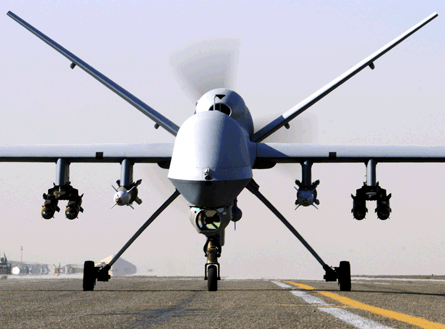The UK Royal Air Force has doubled the level of operational activity with its General Atomics MQ-9 Reaper remotely piloted aircraft in Afghanistan within the last few months, and says a planned fleet expansion will boost this output by a similar margin within the near term.
Controlled by the RAF's 39 Sqn from Creech AFB in Nevada, the UK's Reapers provide persistent intelligence, surveillance, target acquisition and reconnaissance services, and "where required, offensive support to the International Security Assistance Force", says officer commanding Wg Cdr Jules Ball.
Introduced in late 2007, the aircraft have amassed more than 8,000 flight hours in Afghanistan and "are now providing 24/7 coverage", Ball says. "As a squadron we have matured very quickly," he adds.
 |
|---|
© Cpl Steve Bain/Crown Copyright |
The unit has grown to around 100 personnel, including 17 aircrews, each comprising a pilot and sensor operator drawn from types including the BAE Systems Harrier GR7/9, Nimrod MR2 and Panavia Tornado F3. Sorties also involve an image analyst/mission co-ordinator, plus and a two-person launch and recovery team located in Afghanistan.
Current plans call for the UK's Reaper force to eventually grow to more than 40 aircrews, with this rise to match a fleet-expansion plan outlined last December. Six Reapers have so far been acquired for the RAF under urgent operational requirement deals, and a follow-on order is planned for another five, including one to replace a crashed example.
The additional air vehicles and related equipment will be purchased using funds from the core UK defence budget, but operations will continue to be conducted under the UOR framework.
When called upon, the RAF's Reapers can release their two GBU-12 226kg (500lb) laser-guided bombs and four Lockheed Martin AGM-114P Hellfire air-to-surface missiles, but the service says such force has only been used in around 15% of the sorties flown by the type.
Ball says some work is being conducted to look at possible weapon and sensor enhancements, but that there are no current plans to alter the Reaper's configuration from the version also flown by the US Air Force. Any move to integrate UK-specific weapons such as MBDA's Brimstone missile or Raytheon Systems' Paveway IV precision-guided bomb would carry integration costs, he adds.
"There is no doubt that this is the right airframe for the current campaign," says Ball. Describing the air vehicle as cost-effective, reliable and comparatively fast, he adds: "It is very rare that we don't get airborne because of serviceability-related issues."
Related blog: LEARMOUNT wonders how long it’s going to be before airliners are remotely piloted
Source: Flight International























